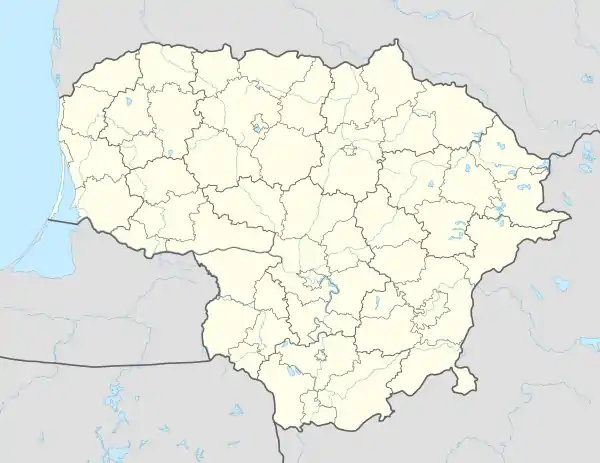Salakas
Salakas is a town in northeastern Lithuania with a population of 519 inhabitants according to the 2011 census.[1] It is famous for the neo-romantic church of Lady of Sorrows. It was built in 1911.
Salakas | |
|---|---|
Town | |
 | |
.png.webp) Coat of arms | |
 Salakas | |
| Coordinates: 55°34′40″N 26°08′00″E | |
| Country | |
| County | Utena County |
| Municipality | Zarasai District Municipality |
| Population (2011) | |
| • Total | 519 |
| Time zone | UTC+2 (EET) |
| • Summer (DST) | UTC+3 (EEST) |
History
The settlement of Salakas was first mentioned in written sources in 1496 when a local noble gifted some land with three serfs to the parish church in Salakas and in 1497 when Wojciech Tabor, Bishop of Vilnius, gifted some land to a governor of Salakas.[2]
In 1554 the town is mentioned as one of the towns on the main trade route from Vilnius to Riga. Because of this Salakas developed as a trading town. Around 1720, a monastery of the Canons Regular of the Penitence of the Blessed Martyrs was built, a wooden church was attached in 1740. After the failed Uprising of 1831, the monastery was closed by the Tsarist authorities in 1832.
Beginning in the early 19th century, there was a significant Jewish population in Salakas because of its status as a trading town. The percentage of Jewish inhabitants ranged from thirty percent to above fifty percent. At the end of August 1941, about 150 Jews from the town – men, women and children – were murdered during the Holocaust in the nearby forest of Sungardai.[3]
After the Polish–Lithuanian War, the Lithuania–Poland border was located several kilometres from Salakas. This meant that the trade going through the town dried up.[2]
References
- "2011 census". Statistikos Departamentas (Lithuania). Retrieved August 13, 2017.
- "Salakas » Salako istorija". www.salakas.lt. Retrieved 2016-04-06.
- http://www.holocaustatlas.lt/EN/#a_atlas/search//page/1/item/190/
